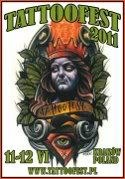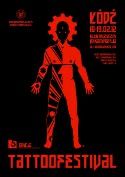
PL:
"Patrzył, jak chłopiec bierze igłę i zanurza ją w atramencie, potem poczuł ostre, łaskoczące ukłucie — igła dotknęła jego skóry. Ból, uporczywy, choć znośny, nie dawał mu zasnąć. (...) Drioli pamięta, że kiedy w końcu artysta odsunął się i powiedział: — Skończone — świtało już i słychać było ludzi na ulicy.
— Chcę to zobaczyć — powiedział Drioli. (...)— Wielki Boże!
Widok był zdumiewający. Całe plecy, od łopatek do pasa, lśniły kolorami — złotym, zielonym, niebieskim, czarnym, szkarłatnym. Tatuaż został nałożony tak grubo, że wyglądał prawie jak impast. Chłopiec szedł wiernie po śladach pędzla nasycając je nową farbą. Znakomicie tez wykorzystał kręgosłup i wystające łopatki, które stały się częścią kompozycji. Co więcej, udało mu się w tym powolnym procesie zachować pewną spontaniczność. Portret był jak żywy i wyrażał tak typowe dla prac Soutine’a cierpienie. Nie chodziło tu o wierne podobieństwo, raczej o nastrój — pijana twarz modelki majaczyła niewyraźnie na tle kłębiących się, ciemnozielonych kresek.
— Jest niesamowity!"
"Skóra" Roalda Dahla (znanego głownie z bajek dla dzieci takich jak Charlie i Fabryka Czekolady czy Fantastyczny Pan Lis) to krótkie ale niezmiernie mroczne opowiadanie o tym co tatuaz robi z ludzmi, z tworcami, nosicielami, widzami i w tym przypadku - czytelnikami.
ENG:
"He watched the boy take up the needle and dip it in the ink; then he felt the sharp tickling sting as it touched the skin of his back. The pain, which was unpleasant but never extreme, kept him from going to sleep. (...) Dnoli could remember that when the artist finally stepped back and said, "It is finished," there was daylight outside and the sound of people walking in the street.
"I want to see it," Drioli said. "Good God!" he cried. It was a startling sight. The whole of his back, from the top of the shoulders to the base of the spine, was a blaze of colour--gold and green and blue and black and scarlet. The tattoo was applied so heavily it looked almost like an impasto. The boy had followed as closely as possible the original brush strokes, filling them in solid, and it was marvellous the way he had made use of the spine and the protrusion of the shoulder blades so that they became part of the composition. What is more, he had somehow managed to achieve--even with this slow process--a certain spontaneity. The portrait was quite alive; it contained much of that twisted, tortured quality so characteristic of Soutine's other work. It was not a good likeness. It was a mood rather than a likeness, the model's face vague and tipsy, the background swirling around her head in a mass of dark-green curling strokes.
"It's tremendous!"
"Skin" by Roald Dahl (a writer mostly known for his books for children like Charlie and the Chocolate Factory or Fantastic Mister Fox) is a short, dark novel about tattoo influence on the tattooer, the owner, the viewer and of course - the reader.















